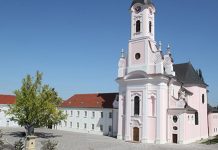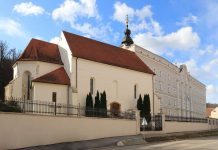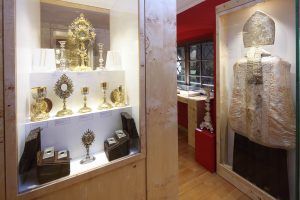 Owing to the specificities of the sacral heritage of Požega’s parish of St Theresa of Avila, especially the need to deposit and preserve it within a church that has become a cathedral, with its liturgical objects used during pontifical celebrations, it has been decided that the Treasury of the Požega Cathedral will be founded apart from the Diocesan Museum, yet historically and conceptually closely linked to it. A Decree from August 31, 2004 on the foundation of the Treasury states the following: “With his apostolic epistle ‘Praeclarum evangelizationis opus’, Pope John Paul II established the Požega Bishopric and elevated the church of St Theresa of Avila in Požega to the status of a cathedral, which means that its furnishing has also gained new significance. During almost two and half decades of the church’s existence, liturgical artefacts of great cultural and historical value, some of which may be deemed antiquities, have been preserved there. Following the abolition of the Jesuit order in 1773, the Pauline order in 1786, the Subaltern Consistory in the first half of the 19th century, and the Archiepiscopal Orphanotrophy in 1946, as well as during the prolonged investigation and renovation of St Laurence’s church in Požega (1961 – 1998), numerous liturgical and archival objects, as well as old books from these ecclesiastical institutions, were transferred to the parish church of St Theresa of Avila. The Treasury of the Požega Cathedral was founded in order to maintain, preserve, renovate, and present this heritage adequately.”
Owing to the specificities of the sacral heritage of Požega’s parish of St Theresa of Avila, especially the need to deposit and preserve it within a church that has become a cathedral, with its liturgical objects used during pontifical celebrations, it has been decided that the Treasury of the Požega Cathedral will be founded apart from the Diocesan Museum, yet historically and conceptually closely linked to it. A Decree from August 31, 2004 on the foundation of the Treasury states the following: “With his apostolic epistle ‘Praeclarum evangelizationis opus’, Pope John Paul II established the Požega Bishopric and elevated the church of St Theresa of Avila in Požega to the status of a cathedral, which means that its furnishing has also gained new significance. During almost two and half decades of the church’s existence, liturgical artefacts of great cultural and historical value, some of which may be deemed antiquities, have been preserved there. Following the abolition of the Jesuit order in 1773, the Pauline order in 1786, the Subaltern Consistory in the first half of the 19th century, and the Archiepiscopal Orphanotrophy in 1946, as well as during the prolonged investigation and renovation of St Laurence’s church in Požega (1961 – 1998), numerous liturgical and archival objects, as well as old books from these ecclesiastical institutions, were transferred to the parish church of St Theresa of Avila. The Treasury of the Požega Cathedral was founded in order to maintain, preserve, renovate, and present this heritage adequately.”
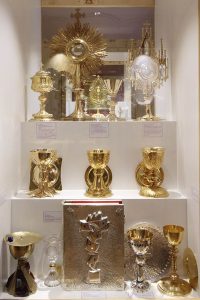 Around seventy sacral objects are preserved at the Treasury, among them liturgical vessels including several late Gothic chalices from the 15th and 16th centuries, liturgical vestments including the mitre of Bishop Franjo Thauszy, builder of the church, as a particularly important artefact, as well as a chasuble, dalmatics, a mantle and a humeral veil that Empress Maria Theresa donated on the occasion of the consecration of Požega’s church of St Theresa in 1763, along with a rococo chalice and handwritten song book from the 17th century. The most recent objects in the Treasury are mostly gifts presented on the occasion of the foundation of the Požega Diocese and the ordination of Bishop Antun Škvorčević on September 27, 1997 and afterwards. These include episcopal pastorals, pectorals, rings, chalices, liturgica
Around seventy sacral objects are preserved at the Treasury, among them liturgical vessels including several late Gothic chalices from the 15th and 16th centuries, liturgical vestments including the mitre of Bishop Franjo Thauszy, builder of the church, as a particularly important artefact, as well as a chasuble, dalmatics, a mantle and a humeral veil that Empress Maria Theresa donated on the occasion of the consecration of Požega’s church of St Theresa in 1763, along with a rococo chalice and handwritten song book from the 17th century. The most recent objects in the Treasury are mostly gifts presented on the occasion of the foundation of the Požega Diocese and the ordination of Bishop Antun Škvorčević on September 27, 1997 and afterwards. These include episcopal pastorals, pectorals, rings, chalices, liturgica
Evangelizing Culture and Evangelizing by Culture
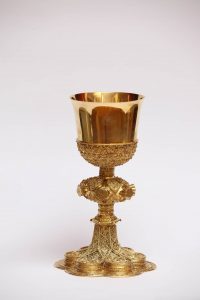 l vestments, and bound evangelistaries and mass books, designed by artists Hrvoje Ljubić, Šime Vulas, Lazer Lumezi, Ana Nada Krpelnik, Vera Klepaj Turnšek, and p. Marko Ivan Rupnik, and produced by Croatian and Italian goldsmith workshops, among others those of Tomislav Rodić and Luciano Ghezzi. The most distinguished donors included Pope John Paul II, Pope Benedict XVI, and the ecumenical patriarch of Constantinople Bartholomew to Bishop Antun, as well as various bishops and priests.
l vestments, and bound evangelistaries and mass books, designed by artists Hrvoje Ljubić, Šime Vulas, Lazer Lumezi, Ana Nada Krpelnik, Vera Klepaj Turnšek, and p. Marko Ivan Rupnik, and produced by Croatian and Italian goldsmith workshops, among others those of Tomislav Rodić and Luciano Ghezzi. The most distinguished donors included Pope John Paul II, Pope Benedict XVI, and the ecumenical patriarch of Constantinople Bartholomew to Bishop Antun, as well as various bishops and priests.
The Treasury is located in the oratory, above the right-hand cathedral sacristy, in order to make the objects preserved there available for liturgical celebrations. It has been designed by Mario Beusan from the Faculty of Architecture, University of Zagreb, and coordinated by Ivica Žuljević, the cathedral parish priest. A scholarly inventory of objects has been produced by Mirjana Repanić-Braun, Arijana Koprčina, Jelena Ivoš, and Nikolina Mandić. The Treasrury has been open to public since 2015.
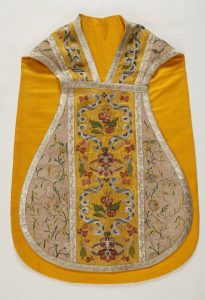 The establishment of the Diocesan Museum in Požega on the 20th anniversary of the Bishopric’s foundation and the Cathedral Treasury a year earlier created new pastoral possibilities for the young local church of Požega, since a permanent museum exhibition of sacral heritage is a very special tool of evangelization and a way for the younger generations, permeated by the culture of globalization, particularly students of Catholic schools in Požega and Virovitica, as well as other believers, to become acquainted with the world they have spiritually grown in and the identity in which they continue to grow in, while all those who do not belong to the community of faith will discover the power and the beauty that have been inscribed into these sacral objects, bringing them closer to God as the source of all beauty. The Collection of Modern and Contemporary Art fulfils this role of sacral heritage as part of the Diocesan Museum. Even though not all the exhibited artworks by Croatian artists are thematically sacral or religious, they nevertheless speak in their own way of the spiritual identity of modern Croatian people and are linked with the artworks of sacral heritage to create a unique whole and a testimony to the life of people in this region from the 15th century to the present day.
The establishment of the Diocesan Museum in Požega on the 20th anniversary of the Bishopric’s foundation and the Cathedral Treasury a year earlier created new pastoral possibilities for the young local church of Požega, since a permanent museum exhibition of sacral heritage is a very special tool of evangelization and a way for the younger generations, permeated by the culture of globalization, particularly students of Catholic schools in Požega and Virovitica, as well as other believers, to become acquainted with the world they have spiritually grown in and the identity in which they continue to grow in, while all those who do not belong to the community of faith will discover the power and the beauty that have been inscribed into these sacral objects, bringing them closer to God as the source of all beauty. The Collection of Modern and Contemporary Art fulfils this role of sacral heritage as part of the Diocesan Museum. Even though not all the exhibited artworks by Croatian artists are thematically sacral or religious, they nevertheless speak in their own way of the spiritual identity of modern Croatian people and are linked with the artworks of sacral heritage to create a unique whole and a testimony to the life of people in this region from the 15th century to the present day.
 I would like to express my cordial gratitude to all the clergy and their assistants, guardians of sacral heritage in the parishes of the Požega Diocese, as well as all those who have shunned no efforts or expertise to present the Diocesan Museum and the Treasury to the general public by contributing to this book: Mario Beusan, author of the concept for the adaptation of the existing building for the Museum and the reading room of the Episcopal Library, the project of the interior of the Museum and the library, and the museological concept and design of the Museum’s permanent collection; I would also like to thank Mirjana Repanić-Braun, Arijana Koprčina, Jelena Ivoš, and Nikolina Mandić for their contributions. I am deeply indebted to all those who have worked on this book under the editorial supervision of Ivica Žuljević and Mirjana Repanić-Braun, to Nikolina Mandić, who has worked on several aspects of the book, particularly on the catalogue items, and to Tomislav Košćak for graphic design. I believe that this book will be a precious thesaurus from which the reader will draw knowledge about the preserved traces of the sacred and the beautiful in western and central Slavonia, especially the city of Požega, from the 15th century to the present day, and discover therein the identity of Croatian people living in this part of our homeland to which we belong.
I would like to express my cordial gratitude to all the clergy and their assistants, guardians of sacral heritage in the parishes of the Požega Diocese, as well as all those who have shunned no efforts or expertise to present the Diocesan Museum and the Treasury to the general public by contributing to this book: Mario Beusan, author of the concept for the adaptation of the existing building for the Museum and the reading room of the Episcopal Library, the project of the interior of the Museum and the library, and the museological concept and design of the Museum’s permanent collection; I would also like to thank Mirjana Repanić-Braun, Arijana Koprčina, Jelena Ivoš, and Nikolina Mandić for their contributions. I am deeply indebted to all those who have worked on this book under the editorial supervision of Ivica Žuljević and Mirjana Repanić-Braun, to Nikolina Mandić, who has worked on several aspects of the book, particularly on the catalogue items, and to Tomislav Košćak for graphic design. I believe that this book will be a precious thesaurus from which the reader will draw knowledge about the preserved traces of the sacred and the beautiful in western and central Slavonia, especially the city of Požega, from the 15th century to the present day, and discover therein the identity of Croatian people living in this part of our homeland to which we belong.



